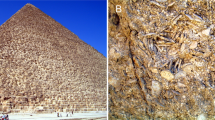Abstract
The maximum lifetime of species with exclusively sexual reproduction covers 5–15 years or even more in aquaria, although most specimens die consecutively earlier. The zooids of paratomic species live some weeks or months, their clones usually less than a year, rarely for some years. In the species with facultative architomy (fragmentation) the clonal age also exceeds that of the individual, both lasting for several years. The actual lifetime of worms in nature may be shorter than in cultures.
Similar content being viewed by others
References
Brinkhurst, R. O., 1964. Observations on the biology of the marine oligochaete Tubifex costatus. J. mar. biol. Ass. U.K. 44: 11–16.
Hämmerling, J., 1924. Die ungeschlechtliche Fortpflanzung und Regeneration bei Aeolosoma hemprichii. Zool. Jb. Allgem. Zool. Physiol. Tiere 41: 581–656.
Hrabě, S., 1939. O vyvoji samčiho vyvodniho aparatu u někte-erych niteňek a žižalic. Sb. Přir. Klubu Třebiči 3: 56–65.
Ivleva, I. V., 1953. Growth and reproduction of Enchytraeus albidus Henle. Zool. Zh. 32: 394–404 (in Russian).
Korschelt, E., 1906. Versuche an Lumbriciden und deren Lebensdauer in Vergleich mit anderen wirbellosen Tieren. Verh. dt. zool. Ges. 16: 113–127.
Learner, M. A., 1972. Laboratory studies on the life-histories of four enchytraeid worms (Oligochaeta) which inhabit sewage percolating filters. Ann. appl. Biol. 70: 251–266.
Mrázek, A., 1914. Beiträge zur Naturgeschichte von Lumbriculus. S.B.k. böhm, Ges. Wiss. (II) 1913, 14: 1–54.
Poddubnaya, T. L., 1966. On the systematics of Chaetogaster diaphanus Gruith. (Oligochaeta, Naididae). Trudy Inst. Biol. Vodokhran 12: 120–124 (in Russian).
Poddubnaya, T. L., 1980a. On the parthenogenesis of Tubificidae (Oligochaeta). Trudy Inst. Biol. vnutr. vod 44: 3–13 (in Russian).
Poddubnaya, T. L., 1980b. Life cycles of mass species of Tubificidae. In R. O. Brinkhurst & D. G. Cook (eds.), Aquatic Oligochaete Biology. Plenum Press, N.Y.: 175–184.
Reynoldson, J. B., 1943. A comparative account of the life cycles of Lumbricillus lineatus Mull. and Enchytraeus albidus Henle in relation to temperature. Ann. appl. Biol. 30: 60–66.
Springett, J. A., 1970. The distribution and life histories of some moorland Enchytraeidae (Oligochaeta). J. anim. Ecol. 39: 725–737.
Štolc, A., 1903. Über den Lebenszyclus der nidrigen Süsswasserannulaten und über einige anschliessende biologische Fragen (Aeolosoma-Arten). Bull. int. Acad. tchéque Sci. 7: 74–130.
Stolte, H.-A., 1962. Oligochaeta. In H. G. Bronns(ed.), Klassen und Ordnungen des Tierreichs, IV, 3,3. Leipzig: 891–1141.
Timm, T. E., 1980. Methods of culturing aquatic Oligochaeta. In Aquatic Oligochaeta worms (Proc. Symp. aquat. Oligochaeta Tartu 1967). Amerind Publishing Co., Pvt. Ltd., New Delhi: 119–131 (translated from Russian).
Author information
Authors and Affiliations
Rights and permissions
About this article
Cite this article
Timm, T. Potential age of aquatic Oligochaeta. Hydrobiologia 115, 101–104 (1984). https://doi.org/10.1007/BF00027901
Issue Date:
DOI: https://doi.org/10.1007/BF00027901




